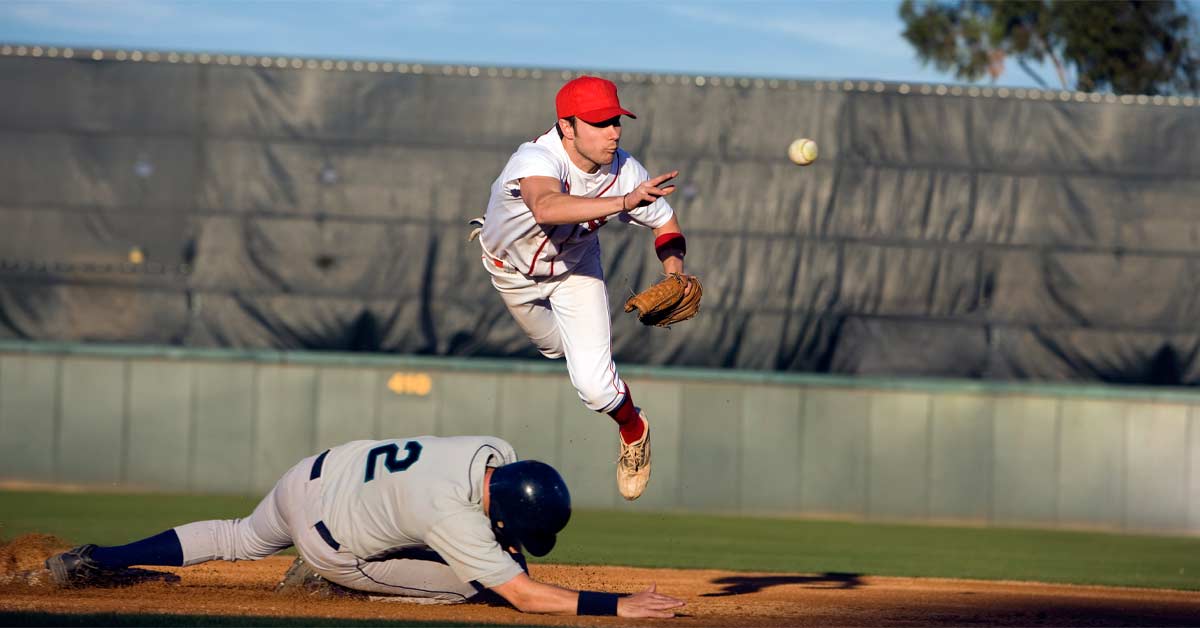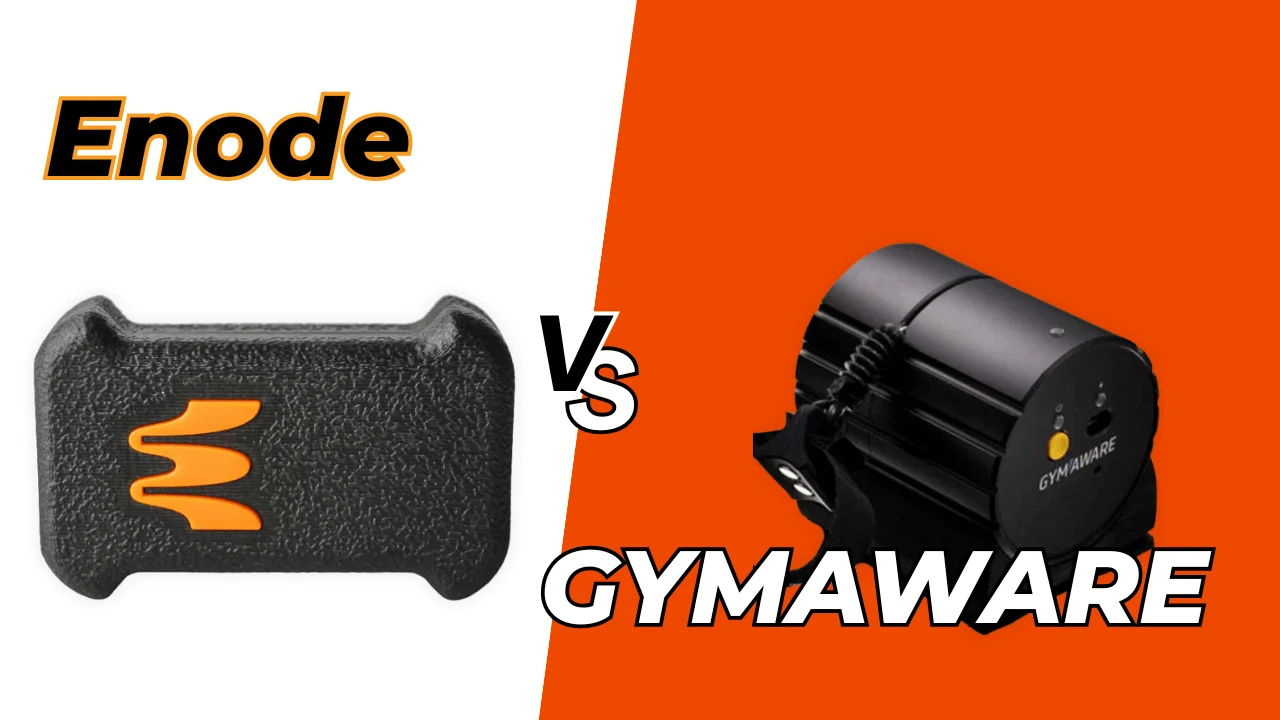“Adapt or die.” – Billy Beane
Strength, power, and speed are essential qualities for an athlete; however, these qualities are quickly diminished if you can’t stay healthy. Fatigue can be described as a decrease in maximal force or power production in response to a contractile activity.1 Managing fatigue over the course of a season remains essential in order to maximize athlete adaptations and minimize potential overreaching.
The field of strength and conditioning utilizes more and more sports science technology every year; with that, there has never been a better time to adopt athlete monitoring protocols. Monitoring athletes can seem intimidating at first—however, as you learn more about the available methods, I am confident you will find what works best for you. As a former collegiate baseball player, I know how quickly the game can be taken away from an athlete. Throughout this article, I will detail my athlete monitoring protocols and the benefits I’ve seen over the course of a season.
Am I saying the use of monitoring protocols will result in zero injuries?
No, that’s not how competitive sports work. However, implementing protocols with the collaboration of all aspects of player development can help bring greater resilience to your athletes and help limit acute injuries.
Implementing protocols with the collaboration of all aspects of player development can help bring greater resilience to your athletes and help limit acute injuries, says @BrettPlatts. Share on X[adsanity align=’aligncenter’ id=11160]
What Is Athlete Monitoring?
Let’s start by diving into what athlete monitoring is—in its purest form, it’s the collection and analysis of data to ensure optimal player performance. As the sports science field continues to grow, so will the methods of monitoring an athlete’s workload. With the various techniques already available, including RPE, GPS, HRV, and questionnaires, there has never been a better time to start monitoring your athletes.
For the sake of this article, I will dive into my method of fatigue management, which relies heavily on utilizing countermovement jumps to monitor fatigue. Given that this is a reliable testing protocol with easy integration into day-to-day operations, I found it fitting to introduce CMJs to my players over the course of the season. For context, my population included academy players within the Chicago Cubs organization, with athletes ranging in age from 16–20 years old. These players are hardworking, passionate young men looking for the opportunity to move up the ranks and further their careers within the organization.
Over the course of this article, I will detail my experience and the benefits I’ve seen implementing specific protocols. As discussed, RPE, GPS, HRV, and questionnaires are excellent methods to use and perhaps more affordable for those who do not have access to force plates. By no means am I here to say what works best; I’m simply highlighting my preferred method of fatigue management through CMJs.
Key Contributions
First things first: be a coach. Provide heart and motivation for your athletes. Build upon the qualities of strength, power, and speed. These qualities make up an athlete’s ability to perform at an elite level.
Second, when entering the realm of sports science technology, create a road map; do not get lost in data collection. It can be easy to overwhelm yourself and collect mass amounts of data while losing the why factor. Analyzing is equally as important as collecting when it comes to comprehending the data received. Furthermore, the physiological and psychological aspects of an athlete’s performance are critical to consider—research has shown that the adaptative response of the autonomic nervous system through training and emotional stressors is directly associated with sport performance.2 To simplify: performance decreases when the athlete’s capacity is exceeded.
My past experiences have heavily shaped my approach to programming and athlete monitoring. As a former baseball player, I can relate to the thoughts many athletes have: “I don’t get tired” or “I’m not tired.” This is a typical psychological tactic many athletes and coaches preach.
In reality, fatigue is a natural occurrence, and it is meant to happen. Unfortunately, I’ve experienced the effects of fatigue. As a player, I remember creating improper mechanics with little-to-no body awareness during long bouts of practice. At the time, I thought nothing of it—just another typical day fighting through fatigue. Then my day and my career ended with a torn ACL and menisci. This dramatic event occurred while fielding a routine ground ball during baseball practice—this is a prime example of how quickly the game can be taken away from someone.
As a professional, this is why I preach athlete monitoring. We must continue to watch and monitor our athletes outside the weight room; having an understanding of their current day-to-day workload is essential before designing protocols. If you have the luxury of being in collegiate or professional sports, monitor practice and look for signs of fatigue—we know fatigue is correlated to an increased risk of an acute injury.3
When creating athlete monitoring protocols, ask yourself the following questions:
- What is the frequency and intensity of practices/games?
- What are the athlete’s current recovery modalities?
- Are they following a nutrition protocol?
- Are they following a hydration protocol?
- What are their sleep habits?
Doing the above will allow for a better understanding of what your athletes deal with on a daily basis.
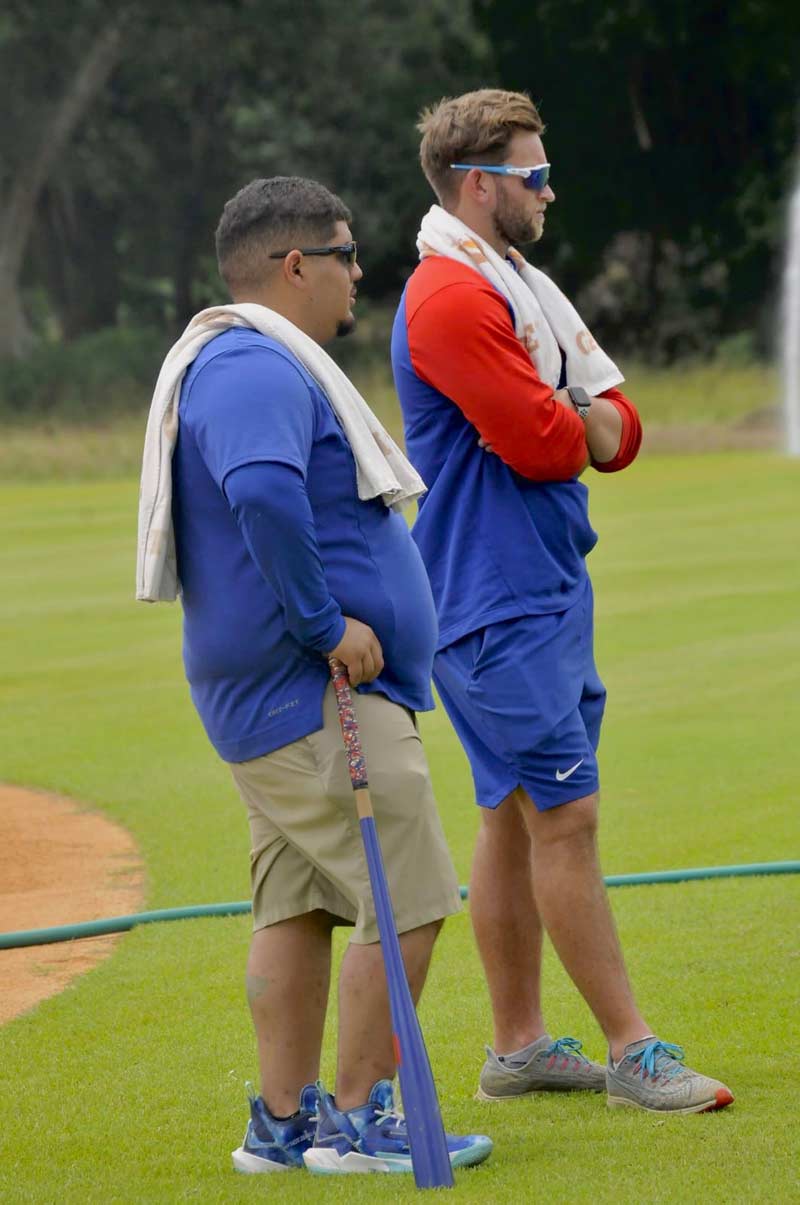
Implementation
Culture is everything. As a strength and conditioning specialist, creating buy-in with all aspects of your organization is essential. This includes players, athletic trainers, coaches, medical staff, and even front office personnel. Communication is key—elaborate and discuss the why factors to all stakeholders in player development.
For players, tell them what you’re doing, explain the tests being done, and show them the metrics you’re looking for. To further increase their motivation, create a leaderboard: players love competition, which will only strengthen the culture within the weight room. You know you have buy-in when players constantly ask what their numbers are.
You know you have buy-in when players constantly ask what their numbers are, says @BrettPlatts. Share on XFor athlete monitoring to work, like-minded conversations must occur daily to ensure optimal player readiness. Building trusting relationships leads to overall player development. Once established, we can now create a longitudinal approach to athlete monitoring.
Utilization
Countermovement jumps are highly reliable movements with the ability to monitor fatigue. For those unfamiliar, the CMJ is a test on a set of force plates to measure an athlete’s lower body power output. Force plates are mechanical sensing systems designed to measure the ground reaction forces involved in human movements.4 The CMJ test consists of an athlete placing their hands on their hips, squatting to a selected depth, and then jumping as high as possible. These tests are performed three times while tracking three key metrics: peak power, depth, and RSI.
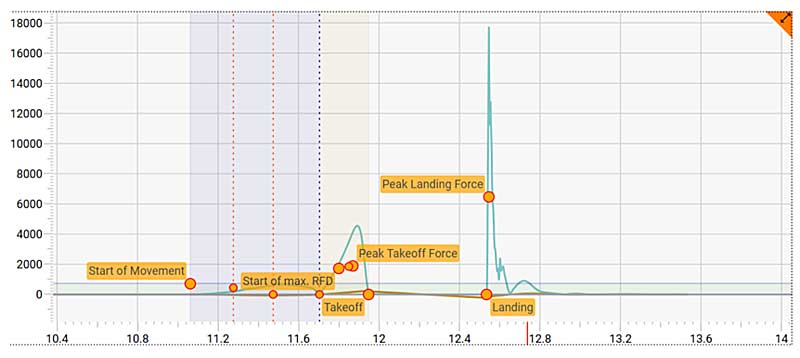
Peak power refers to the highest force and velocity produced by the lower limbs during the stretch-shortening cycle. Peak power remains a critical metric that plays a massive role in sport performance.5 Higher peak power correlates to increased athletic performance qualities, such as power output, acceleration, and sprint performance.
Monitoring depth within the CMJ is essential. Too little or too much depth can significantly alter your results. An athlete reaching less than 30 centimeters of depth will produce more power due to the limited range of motion. On the other hand, an athlete reaching depths greater than 45 centimeters will have a decrease in peak power. Consistency is critical; aim to hit 35–40 centimeters of depth with your athletes. Let athletes be athletes. Naturally, they should switch between 35 and 40 centimeters—have a watchful eye and cue as necessary for valid results.
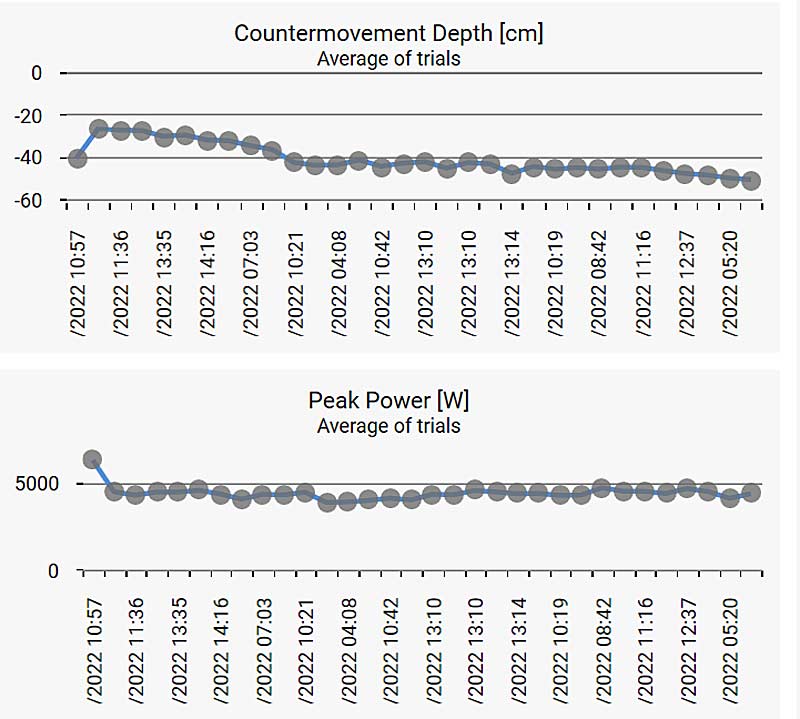
RSI is our final metric, demonstrating an athlete’s ability to change from an eccentric to a concentric movement quickly and effectively. In other words, how fast can an athlete generate force? With the capability to track an athlete’s explosive capabilities through the SSC, we can confidently monitor their ability to generate power throughout the season.
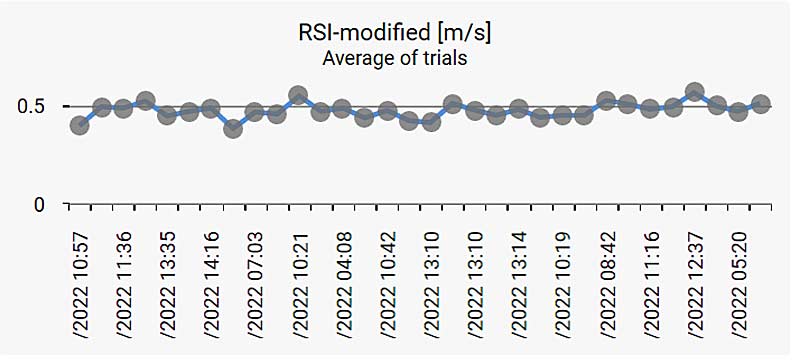
How to Analyze the Data
Now that we have our metrics, we can dive into how to analyze the data received. Figure 4 shows one of my former players experiencing dips in peak power.
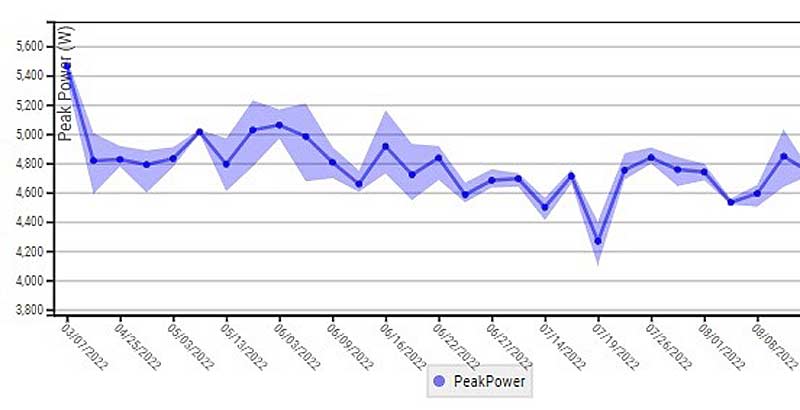
We approach this graph by determining negative trends and implementing specific protocols. As we can see, there are numerous trends in the athlete’s profile. Understand that there will be many highs and lows throughout the season; it’s essential to ensure depth is consistent when evaluating dips to identify outliers. Determining negative trends is vital to monitoring fatigue. Peak power allows us to see the product of force; measuring and tracking this quality over time will enable us to see both power and fatigue and their correlation to a long season.
Peak power allows us to see the product of force; measuring and tracking this quality over time will enable us to see both power and fatigue and their correlation to a long season, says @BrettPlatts. Share on XOnce we are aware of potential fatigue and poor performance indicators, discussions with athletic trainers are our primary resource. If this athlete has entered the training room, determine whether they are receiving treatment for an undisclosed injury. If not, we assume they are healthy with no areas of concern. Once our collaboration with the athletic training staff is established, we can discuss it with the team’s manager and coaches. Have they seen a decline in performance? Are they noticing fatigue? These conversations often bring light to the situation and show a reasonable cause for action. At this point, we can start the athlete on monitoring protocols.
Practices and games will differ per level; however, my experience working with professional baseball typically had the following layout.
- Stretch
- Throw
- Defensive work
- Hitting
- Break
- Game
- Lift (3x/week)
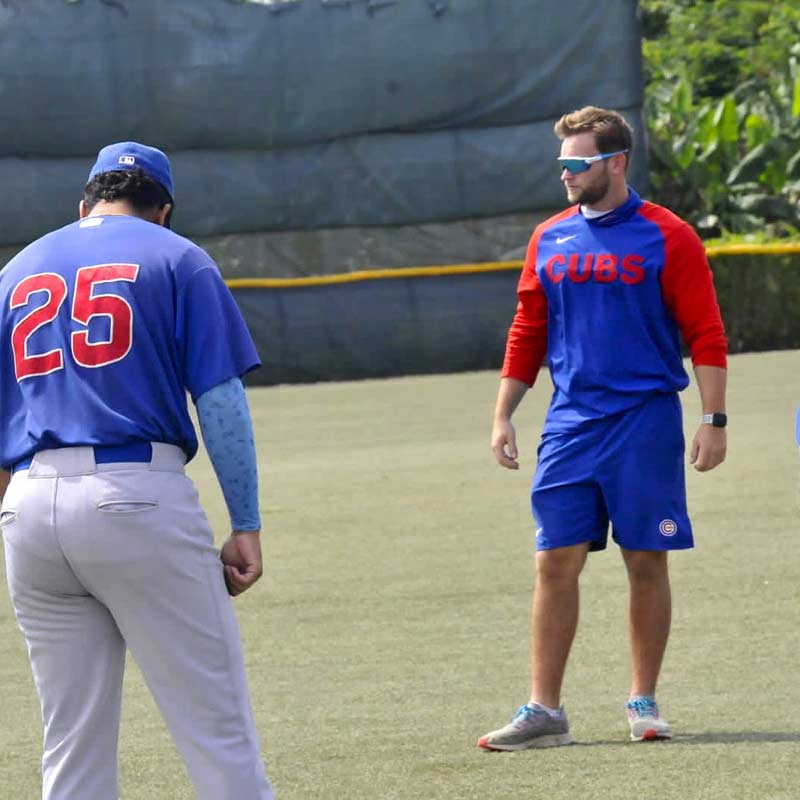
With a detailed schedule, we can scale back on sport workload and high-performance workouts by detecting negative trends. My experience largely included making adjustments to early morning work—this means possible removal from hitting, throwing, defensive work, or even early work altogether. We may see our players stretch, complete a throwing program, and then complete treatment with our ATs. Their workout program is often adjusted by dialing back on volume while keeping a moderate to low intensity, depending on the athlete. Discussions around game removal remain our last resort when determining player readiness.
If protocols are implemented early, the removal from early work activities has been shown to rebound our athletes appropriately. When bucketing athletes into our monitoring protocols, it’s important to note the positive trend back up. Each athlete will recover differently; in my experience, three or more days of an increase in peak power can be an excellent example of increased player readiness.
[adsanity align=’aligncenter’ id=11163]
Monitoring Is Easier Than You Think
The various methods of athlete monitoring protocols can all be practical. Your time, budget, and athletes’ availability will determine what works best for you. Discuss, integrate, and implement the protocols you deem essential. The field of strength and conditioning is meant to be experimental: review the research, ask questions, and integrate what you feel is best for your athletes.
The field of strength and conditioning is meant to be experimental: review the research, ask questions, and integrate what you feel is best for your athletes, says @BrettPlatts. Share on XI monitored CMJ recordings, watched practice, watched games, took the initiative to understand their sleep schedule, and of course, encouraged proper nutrition. If the technology is available, a combination of peak power, RSI, and depth is fully capable of monitoring an athlete’s fatigue. By detecting negative trends, we can rebound players appropriately to ensure player readiness. I credit my success in developing strong, powerful athletes primarily to my coaching and collection of data, which ensures each player physically develops in line with their skills on the field.
Monitoring athletes can seem intimidating; however, I promise it’s easier than you think. We know that with fatigue, there is a greater risk of injury, so detecting and monitoring fatigue remains essential. Workload management is about data collection and interpretation. I am not pulling players from games; however, the long-term benefit of modifying day-to-day operations is huge when limiting acute injuries and furthering an athlete’s career.
Since you’re here…
…we have a small favor to ask. More people are reading SimpliFaster than ever, and each week we bring you compelling content from coaches, sport scientists, and physiotherapists who are devoted to building better athletes. Please take a moment to share the articles on social media, engage the authors with questions and comments below, and link to articles when appropriate if you have a blog or participate on forums of related topics. — SF
References
1. Wan J, Qin Z, Wang P, Sun Y, and Liu X. “Muscle fatigue: general understanding and treatment.” Experimental & Molecular Medicine. 2017;49(10):e384. doi:10.1038/emm.2017.194
2. Aquino M, Petrizzo J, Otto RM, and Wygand J. “The Impact of Fatigue on Performance and Biomechanical Variables—A Narrative Review with Prospective Methodology.” Biomechanics. 2022;2(4):513–524. doi:10.3390/biomechanics2040040
3. Lazarus RS. “How emotions influence performance in competitive sports.” The Sport Psychologist. 2000;14:229–252. doi: 10.1123/tsp.14.3.229
4. Beckham G, Suchomel T, and Mizuguchi S. (PDF) “Force Plate Use in Performance Monitoring and Sport Science Testing.” ResearchGate. Published 10/1/22. https://www.researchgate.net/publication/269631495_Force_Plate_Use_in_Performance_Monitoring_and_Sport_Science_Testing
5. Cronin J and Sleivert G. “Challenges in Understanding the Influence of Maximal Power Training on Improving Athletic Performance.” Sports Medicine. 2005;35(3):213–234. doi:10.2165/00007256-200535030-00003

